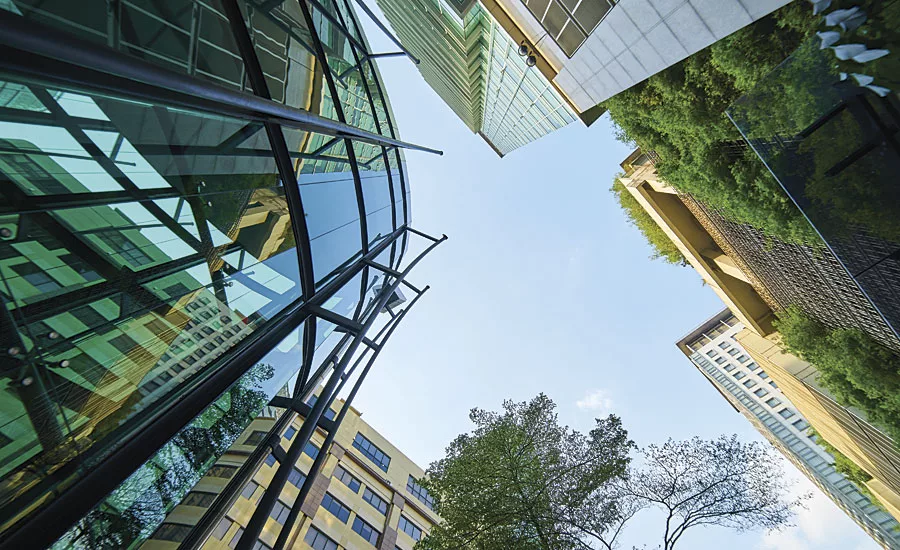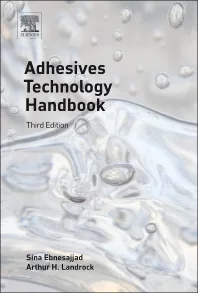Green Buildings and Sustainable Fire Safety Technology – Moving Ahead

Later this month marks the 10th anniversary of World Green Building Week,1 an annual campaign to raise awareness of green buildings and their role in addressing climate change, creating sustainable and thriving communities and driving economic growth. This year’s theme, #BuildingLife, explores how we can create a green and healthy built environment globally and, for the first time, will focus on embodied emissions from the entire building lifecycle – including construction supply chains.
The World Green Building Council defines a green building as one that “in its design, construction or operation, reduces or eliminates negative impacts, and can create positive impacts on our climate and natural environment. Green buildings preserve precious natural resources and improve our quality of life.” There are a number of features that can help buildings to achieve this, including efficient energy and water use, the use of renewable energy, recycling, the use of materials that are non-toxic and ethical, and consideration of the environment in design, construction and operation.
The World Green Building Trends 2018 SmartMarket Report2 surveyed more than 2,000 architects, engineers, contractors, owners, consultants and investors from 86 countries and found that, overall, they expect 60% of their projects to be green by 2021, with demand continuing to grow strongly. Terri Willis, former CEO of the World Green Building Council said, “The study demonstrates that green building is seen by the industry as a key business benefit. Additionally, around the world, green building is considered to have an impact beyond significant environmental benefits.”
Yet, as sustainable construction starts to scale up, driving clear energy and environmental benefits due to changes in materials, products and design, some new challenges are coming to light. One emerging area of research is the nexus of fire safety and sustainable design; first, the concern that sustainable design features may cause unintended increased fire risk or hazards and, second, that building fires, themselves, cause environmental harm.3
Potential New Challenges
Despite the boom in sustainable design, it’s a market in its relative infancy with some new and unconventional materials, techniques and features that have yet to be proven over time. While experts are careful to say that green building design doesn’t equate to increased fire and personal safety hazards, it’s important for owners and designers of green buildings to understand the potential new challenges that are emerging as a direct result of construction choices. Robert Solomon from the U.S. National Fire Protection Association observed, “We’re seeing designs that prescriptive codes don’t address or have not even considered yet.”4
It’s a sentiment shared by Ryan Schoonmaker, Product Manager at specialty chemicals manufacturer, Perstorp. “We understand and welcome the global trend towards green building and we think that, because the industry is in its infancy, now is the time to be addressing safety. In addition to all of the environmental benefits of sustainable design, we should also be thinking about the people using buildings and what happens in the case of a fire catastrophe.”
While research on the topic of fire safety in sustainable building features is somewhat limited to date, one study in New Zealand by researchers from the Victoria University of Wellington, focused on assessing the sustainable features in green buildings and then used an expert group of fire engineers to rank these features in terms of both fire safety and design knowledge to mitigating fire risks in these features.5
As determined by the expert panel, Double Skin Façades (DSFs) had the highest risk score.6 Used for heating and cooling, DSFs are a system of building consisting of two skins, or facades, placed in such a way that air flows in the intermediate cavity. This creates open spaces that are a risk for floor-to-floor fire spread.
Atria - large open-air or skylight-covered spaces surrounded by a building – had the second highest risk score.7 These large open spaces let in more natural light, saving energy and costs, but in case of fire are an opportunity for faster flame growth due to a greater volume of air.
Schoonmaker says both of these sustainable architectural features require support beams with long spans, further increasing fire risk. “The construction and material choices in green buildings set requirements on fire safety that can be overcome with intumescent systems. Even a thin layer of intumescent coating following pro-environment criteria makes a difference.”
Added Protection with Intumescents
Particularly relevant for sustainable buildings, Charmor™ Pro offers a renewable alternative to existing pentaerythritols on the market for use in intumescents. It is a pro-environment polyol ready to be dropped into existing formulations. Based on mass balance concept, it is a partly renewable product designed to reduce the carbon footprint, and supports sustainable sourcing of renewable raw materials. The product is third party-certified according to the ISCC system based on 40% and 100% renewable resources.
Other lightweight materials also need the added fire protection offered by intumescent coatings. In 2012, Brian Meacham, Associate Professor of Fire Protection Engineering at Worcester Polytechnic Institute in the United States, co-authored Fire Safety Challenges of Green Buildings,8 compiling a list of potential hazards associated with sustainable design. The study found, for example, that while lightweight engineered lumber uses less material than conventional builds, the flooring could present risks to firefighters because of a propensity to collapse under fire conditions more quickly than conventional timber construction.
Another fast-emerging trend in sustainable design, also involving timber, that is exciting architects and builders alike, is known as ‘mass timber’ – the approach of using timber as a major structural element in skyscrapers.9 Using engineered wood products that are as robust as their concrete or steel counterparts has a two-decade history in Europe, and it’s now taking off elsewhere. The 18-story, 85-meter Mjösa Tower was officially opened in March this year in Brumunddal, Norway. The world’s tallest timber building, with a hotel, private homes and office space, symbolizes environmentally friendly thinking in construction, proving that tall buildings can be built using wood.
The design assignment of creating such a tall wooden building was a positive challenge for Øystein Elgsaas, architect and partner at Voll Arkitekter. “We want to inspire others to build the same way,” said Elgsaas. And they have. An 18-story mass-timber building was recently completed in Vancouver, there are new commercial mass-timber buildings in London, Atlanta and Minneapolis, and an 80-story-high mass-timber build has been proposed in Chicago.
Green designs also are increasingly introducing unconventional solutions to traditional building problems. The Bahrain World Trade Centre, for example, is the world’s first building to integrate wind turbines into its design. The 240-meter-high towers were completed in 2008, and the project has won several sustainability awards including the 2006 LEAF Award for Best Use of Technology within a Large Scheme, and the Arab Construction World Award for Sustainable Design.
But, the U.S. National Fire Protection Association’s Solomon said that, because buildings like this are not retrofits, a new set of concerns accompany the design. “You’ve got lube oil, concerns over the ignition source and, because some of these turbines have a long wind-down period, you have to be concerned with that. Do you put a braking system on it?” he asks.
From a safety perspective, intumescent systems will need to play a role in mass-timber, steel or concrete sustainable buildings sporting cutting-edge designs we may not have yet imagined. Following green building guidelines, in addition to being the only renewable alternative to existing pentaerythritols, Charmor Pro’s sustainability benefits are recognized under Perstorp’s umbrella of ISCC PLUS certified ingredients. Products in this portfolio provide the same high-performance properties as fossil alternatives but with a much lower carbon footprint.
Perstorp is also launching a new service offer designed to support customers throughout their business cycle – from initial product need to market implementation and beyond. Looking to support every step of the customer journey the new service offer has four key focus areas – Insights & Applications, Innovation & Development, Sustainability Support, and Logistics & Secure Supply. This service will guide and compliment customers involved in the design and construction of innovative, green, sustainable buildings to make the best and most pro-environment choices possible.
Efforts to Improve Sustainable Architecture
Globally, there are increasing efforts to bring together the diversity of expertise that will be needed to keep improving sustainable architecture. Some years ago, a symposium in the United States brought together architects, engineers, regulators, researchers and members of the sustainability community to discuss the challenges and opportunities of integrating fire safety and sustainable design, with an aim to share best practices and chart a path forward for the future.10
In 2017, the third International Sustainable Buildings Symposium was held in Dubai, where researchers presented on everything from smart cities and structural resilience to water and waste management and life cycle assessment. The organizers hope that the ideas generated will spur novel research directions and foster multi-disciplinary collaboration among different specialists.11
With this year’s World Green Building Week about to host hundreds of events globally to highlight the importance of safe and sustainable architecture and construction, it’s timely to think about the the use of ethical and natural materials all along the supply chain when it comes to fire safety, as well as the integration of green design with fire safety such that they reinforce, rather than undermine, each other.
For more information, visit www.perstorp.com.
References
1 https://www.worldgbc.org/calendar/world-green-building-week-2019
2 https://www.worldgbc.org/world-green-building-trends-2018-smartmarket-report
3 https://link.springer.com/article/10.1007/s40518-016-0060-2
4 https://www.facilitiesnet.com/firesafety/article/Green-Building-Design-Can-Pose-Fire-Safety-Challenges--12129
5 https://www.academia.edu/33966717/Sustainable_Building_Features_And_Fire_Safety
6 https://www.academia.edu/33966717/Sustainable_Building_Features_And_Fire_Safety
7 https://www.academia.edu/33966717/Sustainable_Building_Features_And_Fire_Safety
8 https://www.springer.com/gp/book/9781461481416
9 http://global.ctbuh.org/resources/papers/3350-TBIN.pdf
10 https://www.researchgate.net/publication/276276508_Fire_Safety_Design_and_Sustainable_Buildings_Challenges_and_Opportunities_Report_of_a_National_Symposium
11 https://www.springer.com/gp/book/9783319643489
What to Read Next:
Perstorp Explores Project to Produce Recycled Methanol
Perstorp Capacity Expansion Will Boost Annual Penta Production
Looking for a reprint of this article?
From high-res PDFs to custom plaques, order your copy today!






